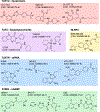Therapeutic synthetic and natural materials for immunoengineering
- PMID: 38170619
- PMCID: PMC11557218
- DOI: 10.1039/d3cs00805c
Therapeutic synthetic and natural materials for immunoengineering
Abstract
Immunoengineering is a rapidly evolving field that has been driving innovations in manipulating immune system for new treatment tools and methods. The need for materials for immunoengineering applications has gained significant attention in recent years due to the growing demand for effective therapies that can target and regulate the immune system. Biologics and biomaterials are emerging as promising tools for controlling immune responses, and a wide variety of materials, including proteins, polymers, nanoparticles, and hydrogels, are being developed for this purpose. In this review article, we explore the different types of materials used in immunoengineering applications, their properties and design principles, and highlight the latest therapeutic materials advancements. Recent works in adjuvants, vaccines, immune tolerance, immunotherapy, and tissue models for immunoengineering studies are discussed.
Conflict of interest statement
Conflicts of interest
There are no conflicts to declare.
Figures







References
Publication types
MeSH terms
Substances
Grants and funding
LinkOut - more resources
Full Text Sources
Medical

